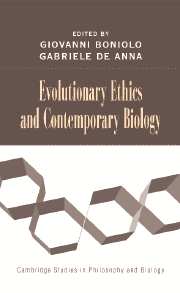Book contents
- Frontmatter
- Contents
- List of Contributors
- Evolutionary Ethics and Contemporary Biology
- Introduction
- PART I THE LIMITS OF EVOLUTIONARY EXPLANATIONS AND JUSTIFICATIONS OF ETHICS
- PART II METHODOLOGICAL ISSUES CONCERNING EVOLUTIONARY ACCOUNTS OF ETHICS
- 3 Are Human Beings Part of the Rest of Nature?
- 4 The Nature of Resemblance: Homologues in the Nervous System and Behavioral Correspondence
- PART III HOW BIOLOGICAL RESULTS CAN HELP EXPLAIN MORALLY RELEVANT HUMAN CAPACITIES
- PART IV HOW BIOLOGICAL RESULTS CAN HELP EXPLAIN MORAL SYSTEMS
- Index
- Cambridge Cultural Social Studies
- References
3 - Are Human Beings Part of the Rest of Nature?
Published online by Cambridge University Press: 23 July 2009
- Frontmatter
- Contents
- List of Contributors
- Evolutionary Ethics and Contemporary Biology
- Introduction
- PART I THE LIMITS OF EVOLUTIONARY EXPLANATIONS AND JUSTIFICATIONS OF ETHICS
- PART II METHODOLOGICAL ISSUES CONCERNING EVOLUTIONARY ACCOUNTS OF ETHICS
- 3 Are Human Beings Part of the Rest of Nature?
- 4 The Nature of Resemblance: Homologues in the Nervous System and Behavioral Correspondence
- PART III HOW BIOLOGICAL RESULTS CAN HELP EXPLAIN MORALLY RELEVANT HUMAN CAPACITIES
- PART IV HOW BIOLOGICAL RESULTS CAN HELP EXPLAIN MORAL SYSTEMS
- Index
- Cambridge Cultural Social Studies
- References
Summary
The issue we want to address is not whether human beings should be understood naturalistically or supernaturalistically. Rather, our question concerns the kinds of naturalistic explanations that are needed to account for the features that human beings exhibit. If a factor C helps explain some feature E of nonhuman organisms, should we infer that C also helps explain E when E is present in human beings? The choice that interests us is between unified and disunified explanations. Do human beings fall into patterns exhibited by the rest of nature, or are we the result of fundamentally different causal processes?
Although evolutionary theory is often seen as the vehicle for understanding human beings as part of the natural order, it would be wrong to assume that evolutionary explanations are automatically unified. An evolutionary explanation for why two species have a feature need not claim that they have that feature for the same reason. Fir trees are green and so are iguanas, and there is an evolutionary explanation for each of these outcomes; however, iguanas and fir trees are green for very different evolutionary reasons. In fact, within an evolutionary framework there are four possible patterns of explanation, not just two; these can be described by beginning with the three options depicted in Figure 3.1.
In case 1, the two species (S1 and S2) are similar because they inherited their shared feature from a common ancestor (A); the similarity is a homology.
- Type
- Chapter
- Information
- Evolutionary Ethics and Contemporary Biology , pp. 43 - 55Publisher: Cambridge University PressPrint publication year: 2006



